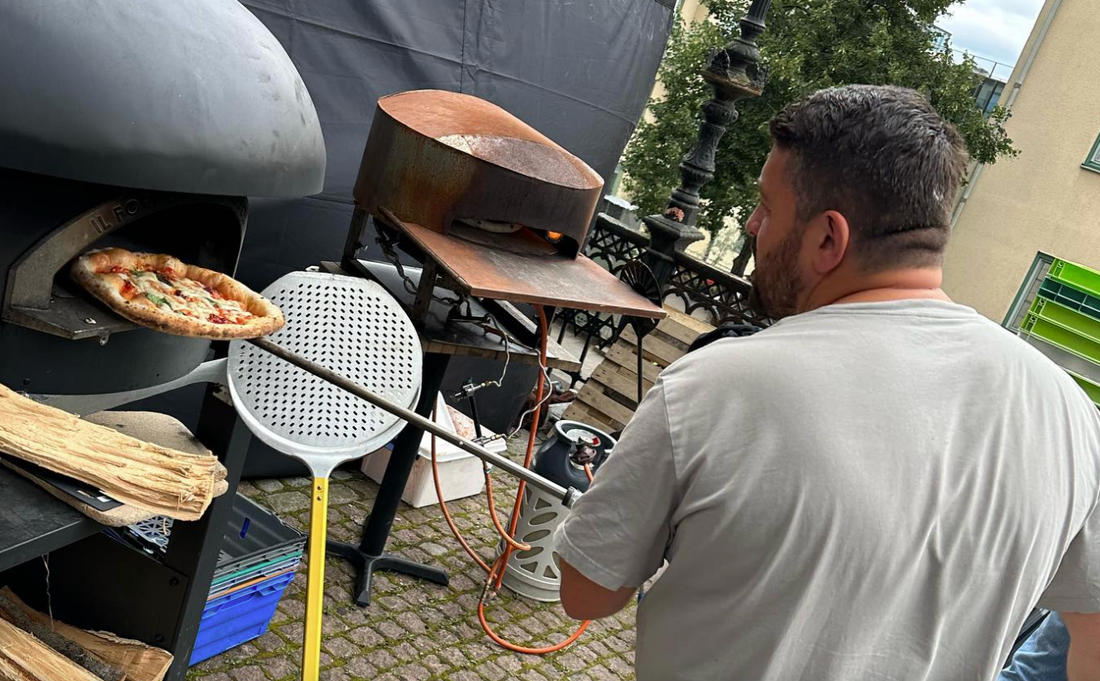To bake Neapolitan pizza, you need a good pizza peel. It's that simple. The moment when the pizza has to be slid into the oven might seem obvious, but a functioning technique and a suitable pizza peel are crucial to success.
In this pizza peel guide, we will tell you everything we think you need to know about pizza peels, including which material is best and some thoughts on usage. Finally, you will also be able to quickly read about our pizza peels, which if you ask us, are pretty good :)
Why a good pizza peel is so important
A good pizza peel is not something to neglect when it comes to Neapolitan pizza, and there are three valid reasons for this.
Firstly, it is extremely frustrating when trying to get the pizza into the oven, and it simply won't slide off the peel. A bad peel can also have other annoying features, such as being too heavy, uncomfortable in the hand, or something else entirely.
Secondly, you can get worse results if you don't succeed in getting the pizza in smoothly and correctly. The pizza can become unevenly baked, overdone, etc.
Last but not least, the pizza peel together with the turning peel (and the oven of course) is the only utensil you need for the baking part of pizza making. So you don't need any other strange oven tools, and since you need so few things, you might as well put a little extra energy into what is actually needed.
Aluminium or wood? - The best material for the pizza peel
In the restaurant, we use aluminum pizza peels. Previously we always used wood, mostly because they slide better once they've been broken in. Also, they work better when some moisture has got on the peel, from, for example, a tomato sauce that has run off the edge.
We use aluminum peels at the pizzeria and when we're out with guests because they are more durable, and we often put in hundreds of pizzas per day, which makes the peel wear out quickly. Then moisture doesn't affect aluminum peels either.
So which one should you have? Well, it's actually not that easy to answer. Wooden peels are better at getting pizza into the oven since they don't stick as easily and have a better glide. However, they are not as durable and require more care. The final thing to consider is that an aluminum peel is better for turning the pizza, so if you don't want to invest in a turning peel, it may be the better choice.
Pizza peel 101 - Usage and cleaning
How to use a pizza peel
First and foremost, we must say that it takes a bit of time to get really good at sliding Neapolitan pizzas into the oven with a pizza peel. It's hard to teach via text, and basically, you just have to try and practice. We encourage everyone to read more closely on how to become a pizza peel king in our book, but here are some quick tips:
- Be quick and decisive: Always keep in mind that the pizza peel should pull back, while the pizza should stay put. If you're going to pull off the tablecloth from a set table, you need a good jerk, and the same goes for the pizza. No messing around here.
-
Have the right grip: Just like in all racket sports, the grip is important to get the right technique. A good way to get an efficient grip is to first grab the pizza peel with your dominant hand relatively close to the end of the shaft. Then grip the peel in the same way that you would if you were playing beach tennis (knuckles facing the ground, while fingertips and thumb are on top. Voilà, you're done.
-
Practice, practice and practice: Practicing is something you can't evade. Above all, we think it's important to get the right speed. Many beginners are initially too slow, but then some have a tendency to become too fast. Generally, you're too slow if the pizza becomes elongated, and you're too fast if it becomes wide and too small. It's all about small margins!
How to maintain your pizza peel
Keeping your pizza peel nice and good is not rocket science; you just need to be consistent.
For wooden peels, wipe off with a damp cloth after use. Avoid soaking. If necessary, clean with warm water and mild dish soap, but then you must wipe it very thoroughly.
When it comes to aluminum peels, the job is often easier. Here you usually only need to wipe off with a cloth, but of course, you can use warm water and mild dish soap if needed. However, you should still wipe it off, and avoid rough and abrasive cleaning agents.
Pizza peel or turning peel - What should you have?
We believe that you should have both a regular pizza peel and a turning peel. The reason is that they fulfill different functions, and they are, after all, the only thing you need. The pizza peel is perfect to slide in a sticky unbaked pizza, while the turning peel is good for turning the pizza with its length and lightness.
If you have an aluminum peel with a slightly longer shaft, you may skip the turning peel, but if you have a small wooden pizza peel, a turning peel is something you should definitely look at.


